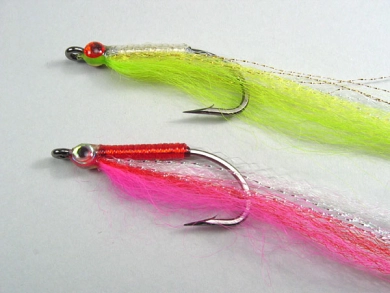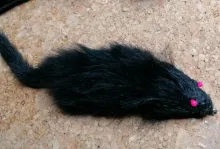Mark Dysinger presents a pair of pike flies that can take a beating - the Prince of pike and the Poxy Bunny. Large, durable and easy to tie as pike flies should be. Mark has used them extensively for his own Northern pike fishing
Northern pike are one of my favorite fish to chase with a fly. The only real drawback to this type of fishing is the rate at which the fish tear through flies with their sharp teeth. When the bite is on, it's not unusual to see several nice flies get chewed up beyond recognition and practical utility. While its fun to see the destructive nature of these predators, having pike shred your offerings cuts into fishing time by requiring the frequent replacement of damaged flies.
In the interest of durability, I have come to tie pike flies that use few natural materials such as bucktail, deer hair, and hackle. In my opinion, these components just don't last long enough after assaults by toothy fish. Instead, I tend to incorporate synthetics that lend themselves to flies that not only last longer, but still have great action in the water and will grab the attention of Mr. Esox.
Heir Apparent
For shallow waters, I use a fly that is modeled after Flip Pallot's Prince of Tides. This fly is well known to most saltwater flyfishers because of its wonderful combination of realism and utility. By having the materials tied in so that the hook point rides up, it can be worked through serious cover without fear of snagging. This feature has definite appeal in pike fishing, where vegetation, wood, and rock are par for the course.
Flip's pattern is tied with a wing of bucktail, which doesn't last long with sharp teeth. He does over wrap the belly flash with hard mono, lending a great deal of durability to that area, but using mono seriously limits the choices of belly color because it only shows the flash underneath.
The Prince of Pike takes Flip's pattern into a realm of durable synthetics and a wider selection of belly colors. Flat tinsel is tied on the shank, but instead of over wrapping this flash with mono I over wrap it with Larva Lace body material. This artificial material comes in a wide variety of colors, and is quite pliable. The material must be stretched and wrapped onto the hook tightly; if not, it will remain bulbous and be susceptible to damage by pike teeth. By using different combinations of flat tinsel and Larva Lace material, you can create a wide assortment of color variations for the belly without losing toughness.
Super Hair
There are many artificial fibers on the market, but I have really come to like Super Hair for its combination of durability and suppleness. Other artificial hairs have more action, but they are finer, wispier, weaker, or a combination of all three. By using Super Hair as the wing material, this pattern can catch many pike before succumbing to their dentures. A touch of Icelandic sheep hair on top of the Super Hair wing gives a nice hint of fluidity in the water. Although this natural hair isn't as tough as the synthetics, I believe it to be one of the more robust natural fibers available. I use Krystal Flash in the wing because it's sturdier than other flash materials like Angel Hair or Flashabou.
It's a good idea to keep a small comb handy when fishing this fly. The fibers can become tangled after being taken by a fish, and a small comb brushes them back into shape quite easily. In order to reduce fouling and tangles from repeated casting, the pattern is not tied heavily. Besides, a fly that is overdressed with synthetic hairs can be a real bear when it gets tangled in the mouth of a large fish. In such a case, getting the hook barb free may be easier than untangling the hairs from the fish's teeth.
Rascally Rabbit
While the Prince of Pike has a definite niche in relatively shallow waters, there are times when the pike hold in areas that are out of that fly's practicality. Enter the Poxy Bunny, a pattern that drives the water wolves nuts when they are holding in intermediate depths. This is another fly that takes the abuse of sharp teeth by utilizing synthetics. It also incorporates one of the most durable natural materials that I know of, rabbit hide strips. Magnum zonker strips have a very seductive wiggle in the water, and they can also take an impressive amount of harm. I have yet to encounter a pike that can completely chomp through one of these large pieces of hide, although some have shown signs of wear over a day's worth of fishing.
The Poxy Bunny has a magnum zonker strip tail that is approximately twice as long as the hook shank. A wire loop guard at the hook bend helps to prevent fouling of the tail during casting. The main body of the pattern is entirely synthetic: sparkle braid under epoxy. This combination allows the glistening braid to subtly shine through a tough outer shell. Dumbbell eyes ensure that the fly sinks well and rides with the hook point up. It should also be noted that I tie this fly on saltwater hooks because they are tougher and the added weight helps to get the fly down in the water column.
I prefer to use red thread with this pattern. Regardless of the main color of the fly, the head in front of the eyes will always show red under the epoxy, and I firmly believe that a little bit of red in pike flies goes a long way. In addition, I always use pearl sparkle braid. After it's tied in and prior to epoxy application, I can color it with sharpies or highlighters to match or contrast with the color of the zonker tail, or leave it as is to match a white tail. These two points are personal preferences only, and your mileage may vary.
At first glance, this fly pattern may appear to be a bit unwieldy. Keep in mind that the zonker tail sheds water very quickly, usually with the first back cast. Also, the body is sealed by epoxy and will not absorb any water at all. These features make the pattern quite manageable. I do most of my pike fishing with a nine weight outfit, which handles this pattern just fine. In a pinch, I've also gone down to an eight weight and had no problems to speak of.
- Log in to post comments

















thanks for the patte
thanks for the patterns... will give them a try and let u know how i get on
Nice clean patterns.
Nice clean patterns. They look like they'd shrink down to worm-like shapes when wet though. For big pike I found, girthy flies get their attention more often than skinny flies.
Just a tip. ;-)
Always looking for n
Always looking for new flies for pike. I have been after the toothie ones for 5 years now. Here in the Finger Lakes Region of NYS. Pike fishing is picking up once again. I will make these flies and give them a try.
Fly fishing for pike
Fly fishing for pike is starting to become very popular in the uk.We are getting a little bored with catching those stocked rainbows ! Pike have fascinated me since i was a little boy and i cant wait to get started ! Also , my eyesight is not very good, so tying up much bigger flies for pike will be much better for me.
Thank you very much for your most interesting article.
Best wishes
Stuart Duke
Nice article...and n
Nice article...and nice flies.
Regards
opettersson
www.flyzone.se